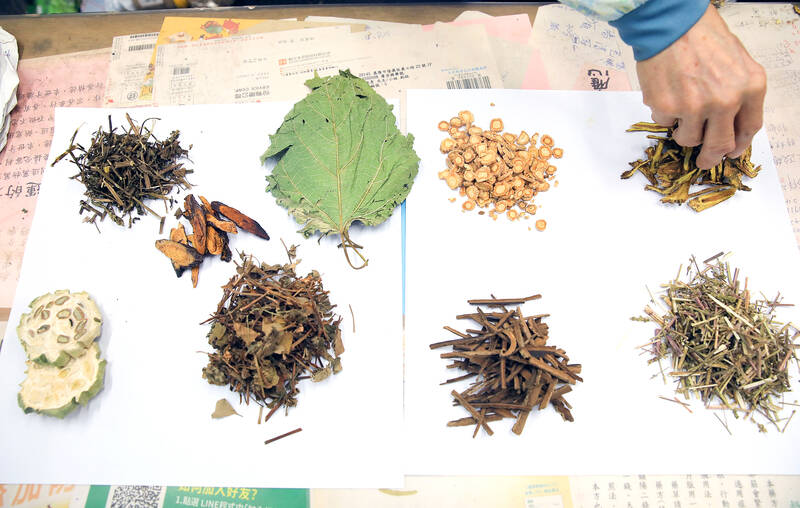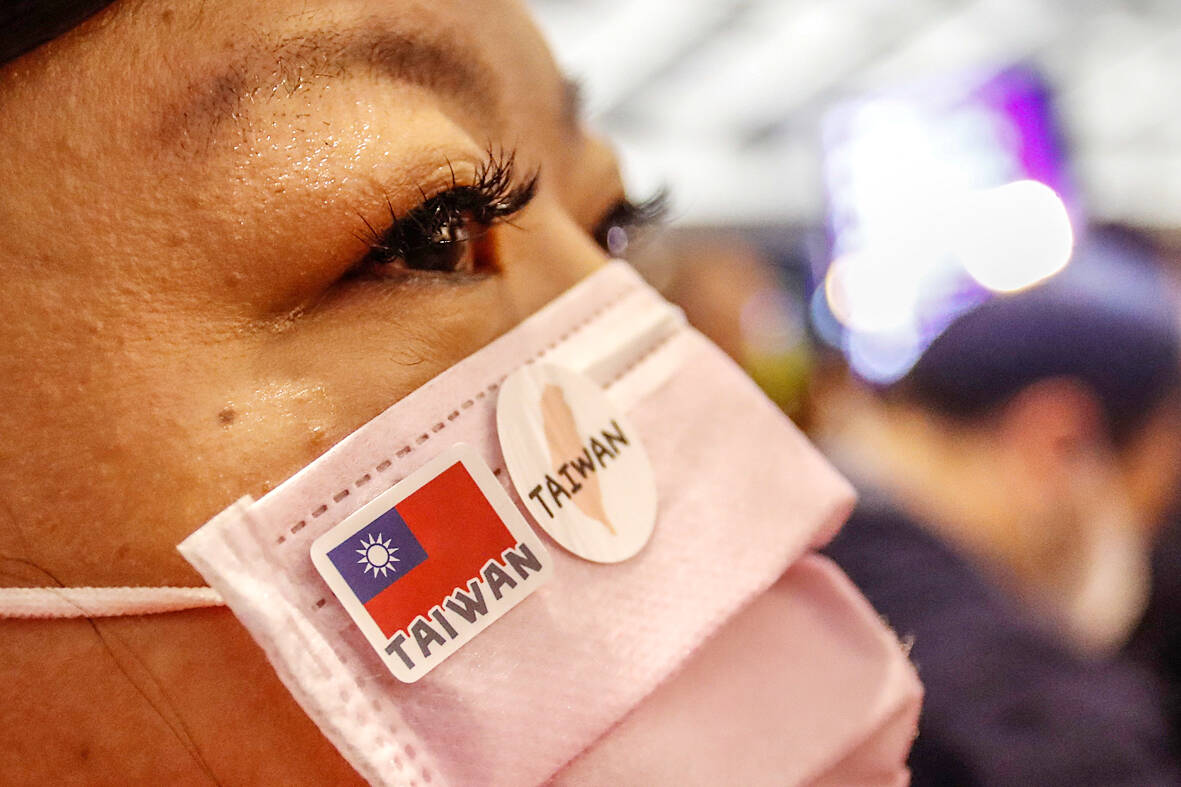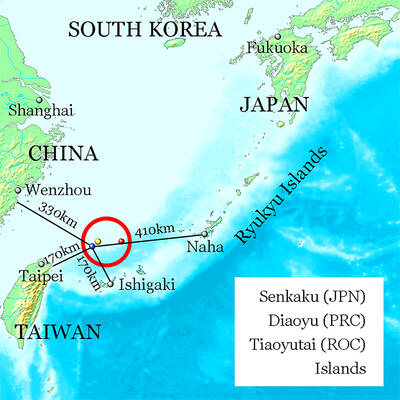Last Wednesday marked the 12th day in a row in which the number of COVID-19 cases in Taiwan was lower than the number the previous week on the same day. The figure for that day was over 19,000 reported cases.
People are now accepting this figure, somewhere between 15,000 and 20,000, as background noise, and the government is contemplating reducing the mask mandate. It appears that we are about to normalize the cost of COVID.
LONG COVID

Photo: Bloomberg
It’s sobering to calculate: at 19,000 cases a day, every 60 days Taiwan experiences over 1.1 million cases, with all the attendant costs. A meta-analysis of studies of long COVID in the Journal of the American Medical Association found that 6.2 percent of COVID suffers will develop at least one of the three major clusters of long COVID symptoms.
Of those, according to that study, in roughly 15 percent, or 1 percent of all COVID cases, symptoms will persist for a year or longer. That means that every 60 days Taiwan will be generating 10,000 cases of long COVID of a year’s duration, which in many cases renders victims unable to work. That’s 60,000 such cases annually.
In a study of US cases, 15 percent of COVID victims developed long COVID (persisting two months after the initial infection), with unvaccinated individuals suffering disproportionately. Recall that low vaccination rates among the elderly in Taiwan remain an issue. In another study of over 3,000 long COVID suffers from 56 countries, the majority reported that symptoms lingered for more than 35 weeks.

Photo: Reuters
Of course, those are majority experiences. The outliers are simply insane. Ed Yong in an article for The Atlantic described a case of brain fog that lasted a terrifying 900 days. The victim once worked in AI, “but now ‘runs into a mental wall’ when faced with tasks as simple as filling out forms.”
QUACKERY
It is conventional to calculate the economic losses from deaths, caring for COVID cases, treating long COVID cases and lost work hours. Less obvious to many who have thought about this will be the diversion of investment to socially frivolous purposes, such as “alternative” medicines and their attendant “treatment” infrastructure.

Photo: AFP
In the first half of the last century there was an extensive sanitorium movement for tuberculosis, which did nothing to cure the disease, but planted sanitoria in all sorts of countryside in the belief that clean dry air was good for the disease. Tuberculosis was the most famous rationale for sanitorium building, but they were also built for a variety of other “ailments,” including “hysteria,” fatigue and masturbation.
It is easy to see how that might play out with long COVID, especially in a society that has a widely accepted existing formal system of traditional Chinese medicine as an alternative to scientific medicine. I look forward to the late-night cable TV and radio ads in rapid-fire Taiwanese extolling the virtues of patent medicines for long COVID issues. This will receive impetus from the common experience of long COVID sufferers: doctors don’t listen to them. Multiply that by the short, peremptory doctor visits that characterize Taiwan’s health system.
SOCIAL COSTS
As with other long-term diseases, long COVID will also generate a host of social costs. Sufferers will put off marriage and children, and lose not just work time (and their jobs) but also learning and promotion opportunities. In Africa this is a common problem with diseases like malaria, which has easily measurable effects on worker productivity.
In children it will harm school performance. “Brain fog” is reported in many cases of long COVID, nearly 70 percent, with up to 78 percent reporting inability to concentrate, according to one study. The school system here runs on rote memorization, after all.
In Sweden, where the virus was essentially permitted to run rampant, an insurance company survey found that 32 percent of the 18-24 age bracket reported brain fog, affecting their social, work and school lives.
That’s what living with COVID means. That’s what happens when it becomes normalized. Around every four years, at the current pace, we will generate enough cases to infect everyone in Taiwan. Many of those will be reinfections, of course. It goes without saying that studies show reinfections worsen both the chance of getting long COVID and its destructive effects.
Nor does anyone really know what the long term effects of the disease are. It is still too new.
The national health insurance system allocates hospital beds and other medical resources on a geographical basis, with a strict number of beds for a given population. This means that the system has few slack resources, an impediment that has slowed the development of a robust medical tourism system here. COVID cases and long COVID will further strain the system, a strain that will become constant over time.
An excellent 2020 piece by Jane Rickards in AmCham’s TOPICS magazine described some of the trends in hospital administration and health care in Taiwan. Typically, the national health insurance covers 56 percent of health care costs, while the remaining 44 percent (read: future long COVID costs) comes from the patient’s pocket. The elderly constitute 15 percent of the insured population, but almost 40 percent of medical expenses.
One of the experts consulted for the piece noted that Taiwan lags behind South Korea and Japan in care for chronic diseases. With Taiwanese averaging 15 visits a year to local clinics and hospitals, the piece says, Taiwan’s system is geared for quantity, not quality of care, and long-term diseases that require patient monitoring and management, such as diabetes, are less well served by the system. Long COVID is a long-term disease.
The death numbers bounce around, last week falling between roughly 35 and 65 a day. At 40 deaths a day, Taiwan will experience 1,200 a year, comparable to the 1,648 people who lost their lives in scooter-related accidents in the first 10 months of last year. It could well be more.
We have decided, in our weariness with travel restrictions and mask orders, to declare that we are done with COVID, to accept all the lost lives and lost years of work and individual growth as the cost of doing business.
After all, that always happens to other people, right?
Notes from Central Taiwan is a column written by long-term resident Michael Turton, who provides incisive commentary informed by three decades of living in and writing about his adoptive country. The views expressed here are his own.

The Nuremberg trials have inspired filmmakers before, from Stanley Kramer’s 1961 drama to the 2000 television miniseries with Alec Baldwin and Brian Cox. But for the latest take, Nuremberg, writer-director James Vanderbilt focuses on a lesser-known figure: The US Army psychiatrist Douglas Kelley, who after the war was assigned to supervise and evaluate captured Nazi leaders to ensure they were fit for trial (and also keep them alive). But his is a name that had been largely forgotten: He wasn’t even a character in the miniseries. Kelley, portrayed in the film by Rami Malek, was an ambitious sort who saw in

It’s always a pleasure to see something one has long advocated slowly become reality. The late August visit of a delegation to the Philippines led by Deputy Minister of Agriculture Huang Chao-ching (黃昭欽), Chair of Chinese International Economic Cooperation Association Joseph Lyu (呂桔誠) and US-Taiwan Business Council vice president, Lotta Danielsson, was yet another example of how the two nations are drawing closer together. The security threat from the People’s Republic of China (PRC), along with their complementary economies, is finally fostering growth in ties. Interestingly, officials from both sides often refer to a shared Austronesian heritage when arguing for

Among the Nazis who were prosecuted during the Nuremberg trials in 1945 and 1946 was Hitler’s second-in-command, Hermann Goring. Less widely known, though, is the involvement of the US psychiatrist Douglas Kelley, who spent more than 80 hours interviewing and assessing Goring and 21 other Nazi officials prior to the trials. As described in Jack El-Hai’s 2013 book The Nazi and the Psychiatrist, Kelley was charmed by Goring but also haunted by his own conclusion that the Nazis’ atrocities were not specific to that time and place or to those people: they could in fact happen anywhere. He was ultimately

Last week gave us the droll little comedy of People’s Republic of China’s (PRC) consul general in Osaka posting a threat on X in response to Japanese Prime Minister Sanae Takaichi saying to the Diet that a Chinese attack on Taiwan may be an “existential threat” to Japan. That would allow Japanese Self Defence Forces to respond militarily. The PRC representative then said that if a “filthy neck sticks itself in uninvited, we will cut it off without a moment’s hesitation. Are you prepared for that?” This was widely, and probably deliberately, construed as a threat to behead Takaichi, though it